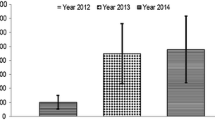Abstract
Background
Little is known about the economics of acquiring and processing the more than 14 million units of red blood cells used annually in the US.
Objective
To determine the average price paid by hospitals to suppliers for a unit of red blood cells and to identify cost variations by region and facility type and size. A secondary objective was to examine costs for additional blood components as well as costs for blood-related processes performed by hospitals. Qualitative input was sought to identify potential cost drivers.
Methods
A cross-sectional survey was performed of a randomized sample of hospital-based blood bank and transfusion service directors. The survey instrument assessed costs of specific blood components and services as incurred by hospitals. Analysis of variance was performed to test for significant variation in costs for red blood cells by geographic region and division, facility type and bed capacity.
Results
A total of 213 surveys were completed. The mean (SD) acquisition cost for one unit of red blood cells purchased from a supplier (n = 204) was $US210.74 ± 37.9 and the mean charge to the patient (n = 167) was $US343.63 ± 135. There was significant statistical variation in acquisition cost by US census region (p < 0.0001) and division (p < 0.0001). Teaching hospitals were more likely to receive volume discounts than other facility types. The mean prices paid per unit for fresh frozen plasma (n = 167) and apheresis platelets (n = 153) were $US60.70 ± 20 and $US533.90 ± 69, respectively. The median cost for mandated screening performed onsite (n = 56) was $US50.00 ± 120 and the median storage and retrieval cost (n = 46) was $US68.00 ± 81 per unit. A total of 28% of respondents reported that costs for acquisition, screening and transfusion had ‘increased dramatically’ over the past 5 years and 23% reported that blood shortages were a significant problem.
Conclusions
The cost of blood continues to increase and price varies by geography. However, the rate of increase in acquisition costs for red blood cells appears to be slowing. This information should be used by organizations and policy makers to improve financing and utilization management for blood components and services.



Similar content being viewed by others
References
Whitaker BI, Green J, King MR, et al. The 2007 national blood collection and utilization survey report. US Department of Health and Human Services, 2008 [online]. Available from URL: http://www.hhs.gov/ash/bloodsafety/2007nbcus_survey.pdf [Accessed 2008 Jun 1]
Ness PM. The broken reimbursement system: putting the brakes on the blood safety train. Transfusion 2003; 43(8 Suppl.): 1S–2S
Goodman C, Chan S, Collins P, et al. Ensuring blood safety and availability in the US: technological advances, costs, and challenges to payment — final report. Transfusion 2003; 43(8 Suppl.): 3S–46S
Liberman A, Rotarius T. A new cost allocation method for hospital-based clinical laboratories and transfusion services: implications for transfusion medicine. Transfusion 2005; 45(10): 1684–8
Forbes JM, Anderson MD, Anderson GF, et al. Blood transfusion costs: a multicenter study. Transfusion 1991; 31(4): 318–23
Cantor SB, Hudson Jr DV, Lichtiger B, et al. Costs of blood transfusion: a process-flow analysis. J Clin Oncol 1998; 16(7): 2364–70
Varney SJ, Guest JF. The annual cost of blood transfusions in the UK. Transfus Med 2003; 13(4): 205–18
Tretiak R, Laupacis A, Riviere M, et al. Cost of allogeneic and autologous blood transfusion in Canada: Canadian cost of transfusion study group. CMAJ 1996; 154(10): 1501–8
Amin M, Fergusson D, Wilson K, et al. The societal unit cost of allogenic red blood cells and red blood cell transfusion in Canada. Transfusion 2004; 44(10): 1479–86
Glenngard AH, Persson U, Soderman C. Costs associated with blood transfusions in sweden: the societal cost of autologous, allogeneic and perioperative RBC transfusion. Transfus Med 2005; 15(4): 295–306
Kanavos P, Yfantopoulos J, Vandoros C, et al. The economics of blood: gift of life or a commodity? Int J Technol Assess Health Care 2006; 22(3): 338–43
Cremieux PY, Barrett B, Anderson K, et al. Cost of outpatient blood transfusion in cancer patients. J Clin Oncol 2000; 18(14): 2755–61
Pereira A. Determinants of cost in blood services: blood transfusion from an economic perspective. Expert Rev Pharmacoecon Outcomes Res 2002; 2(3): 201–10
No authors listed. The cost of blood: multidisciplinary consensus conference for a standard methodology. Transfus Med Rev 2005; 19(1): 66–78
Shander A, Hofmann A, Gombotz H, et al. Estimating the cost of blood: past, present, and future directions. Best Pract Res Clin Anaesthesiol 2007; 21(2): 271–89
Whitaker BI, Sullivan M. The 2005 nationwide blood collection and utilization survey report. US Department of Health and Human Services, 2005 [online]. Available from URL: http://www.hhs.gov/bloodsafety/2005NBCUS.pdf [Accessed 2008 Jun 1]
Goldfarb N, Girts T, May R, et al. Economic evaluation of costs associated with blood transfusion [oral presentation]. 54th Annual Meeting of the American Association of Blood Banks (AABB); 2001 Oct 16; San Antonia (TX) [Available upon request to Thomas Jefferson University, School of Population Health]
Acknowledgements
This study and the drafting of this manuscript was funded by Novo Nordisk. The funding organization provided comments on a draft of the survey instrument, and reviewed a draft of the final manuscript. However, the investigators retained full scientific control of the study. The authors have no conflicts of interest that are directly relevant to the content of this article.
Author information
Authors and Affiliations
Corresponding author
Rights and permissions
About this article
Cite this article
Toner, R.W., Pizzi, L., Leas, B. et al. Costs to hospitals of acquiring and processing blood in the US. Appl Health Econ Health Policy 9, 29–37 (2011). https://doi.org/10.2165/11530740-000000000-00000
Published:
Issue Date:
DOI: https://doi.org/10.2165/11530740-000000000-00000




